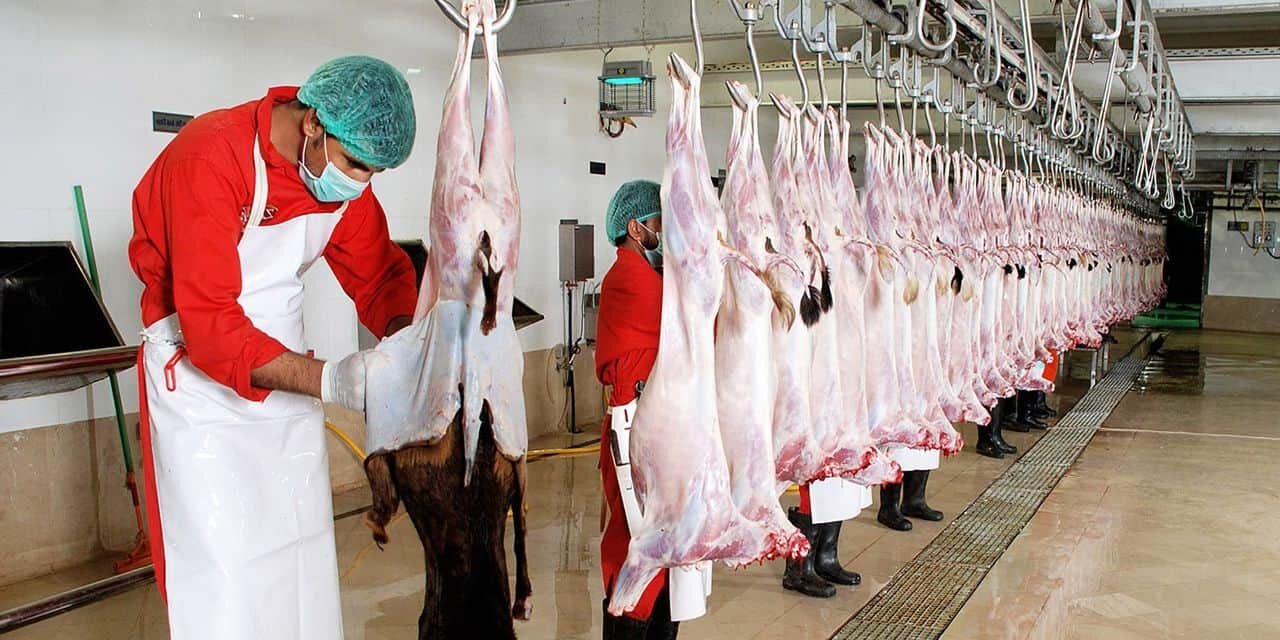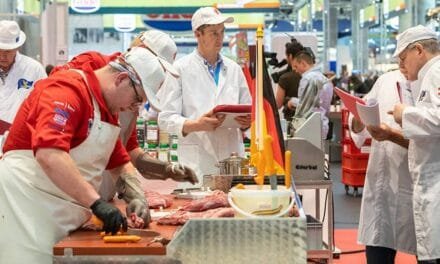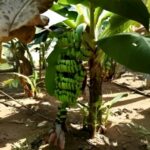Meat consumers are increasingly demanding that animals be reared, handled, transported and slaughtered using humane practices. Therefore, the production of good-quality and hygienic meat for consumers is the primary concern of the abattoir. Suman Talukder explains here various factors to be considered in a modern abattoir for a hygienic meat production chain.
Table of Contents
An abattoir is a premise and building which is used for slaughtering in order to get animal products for human consumption. Swine, cattle, buffalo, goat, sheep, poultry and any kind of animals in accordance with the notification of the National Committee on Agricultural Commodity and Food Standards are slaughtered and produce animal meat and products thereof in a modern abattoir. Production of good-quality and hygienic meat for consumers is the primary concern of the abattoir.
The food animals are raised on the farm, the food chain starts from that very point and ends on the plate of the consumers. Disease-free animals from the hygienically maintained farm can only provide and produce good quality meat and products, these products having appreciable acceptability and shelf life, indirectly influence the economic viability of the meat production chain. The article explains Modern Abattoir Practices and issues related to Animal Welfare, Meat Quality, & Safety.
Proper Layout of an Modern Abattoir for Better Production
A modern abattoir should have all the facilities to cope with meat production. All modern abattoir practices and issues related to Animal Welfare, Meat Quality & Safety, should be followed to maintain a hygienic meat production chain. A modern abattoir should have all the facilities to cope with meat production, and its appropriate layout and management are the most vital concerns.
| 🔗 How packaging extends shelf life of meat
Proper functioning of an abattoir can only channelise the production of quality meat, and this depends only on the appropriate layout of the premises and building, which must be designed so that the production process moves in one direction without any cross-flow of products, which may adversely affect the hygiene of the product. Live slaughter animals are received at the “dirty” end of the abattoir, and meat is dispatched from the clean side of the abattoir.
The various “dirty” areas regarded as critical points in the production chain include the livestock entry point and the lairage, where animals are held prior to slaughter—such as shaded areas for pigs, sheep, and poultry, where applicable. These areas also encompass the ante-mortem inspection zone and the isolation lairage designated for animals or birds that are ill or suspected of being sick.
| 🔗 10 common hazards in food processing industry
Emergency slaughter facilities are provided for injured animals or birds, and specific areas are designated for handling condemned products. Inedible by-products such as hides, pelts, horns, feathers, and similar materials are managed in dedicated rooms or zones. Solid waste disposal areas handle materials like faeces and intestinal matter, while effluent is treated in pre-purification plants and stored in holding tanks.
Additional facilities process condemned products into by-products such as blood meal, carcass meal, and tallow. Finally, there are hygiene and welfare areas specifically for workers assigned to the dirty zones, including cloakrooms, toilets, showers, washbasins, and dining rooms with restricted access.
| 🔗 Properly designed food processing machinery
Considerations during the setup of a modern abattoir
Various factors to be considered when building an abattoir for maintenance of a hygienic meat production chain, the choice of a suitable site is the most important. The factors listed below must, therefore, be taken into account when selecting a premise:
- Drainage system – Drainage is affected by geological structure, nature of the soil (sandy or loam), the water table and the natural slope of the surface.
- Natural slope – Rainwater and runoff from the dirty area must not flow into the abattoir, nor must they flow from the dirty to the clean side of the premises. Tanks for the collection of effluent and pre-purification plants must be situated at the lowest point of the site, on the dirty side. Lairage must not be situated on higher ground than the buildings, nor must they be closer than six meters to them.
- Water supply – An adequate supply of potable water must be available. Consideration should also be given to the storage (storage tanks, chlorination tanks, and pressure tanks) which must be on the clean side, preferably at the highest point, and treatment of water should this be necessary.
- Water pollution – can occur due to slaughtering and other processes and therefore the abattoir should be a reasonable distance away from any river – no process water may flow into any river.
- Prevailing winds – Must blow from the “clean” side (dispatch) to the “dirty” side.
- No source of contamination should occur in the environment in which we place an abattoir: Examples are a paint factory, foundry, sewage farm, river or residential area.
- Abattoirs are classified as light industries. Because water pollution does occur, the abattoir should be a reasonable distance away from any river.
- The site must be large enough to allow the abattoir and allied activities to be correctly situated and oriented. Provide also for future extensions.
Essential Services in a modern abattoir
- Effluent disposal – An effective system for the disposal or removal of effluent must be provided where necessary.
- Electricity – There must be a reliable source of power for heating water as well as to provide for the partial or total mechanization of the abattoir.
- Transport – There must be sufficient facilities for the reception of animals as well as for the removal of products.
- Labour – The proximity of a labour pool or reasonable access to public transport is also important.
- Access roads and staff separation – If this is required for the relevant grade, the “clean” and “dirty” areas of the premises must be physically separated. Vehicles which offload live animals, loads intestines heads and feet as well as vehicles removing paunch contents, condemned material and refuse are restricted to the “dirty” area and may not enter areas where meat vehicles and staff who handle meat are to be found.
Factors affecting hygienic meat production
Progressive procedures to prevent the contamination of meat by organisms and other contaminants during the slaughter process must be taken. This aim can be achieved by correct internal abattoir design and following Modern Abattoir Practices. The layout must eliminate cross-flow patterns of people and products. In designing the abattoir, it is important to refer once again to the principle of a linear flow pattern.
- During meat processing, product flow must be from dirtier to cleaner areas, zones or rooms. These products must not come into contact with the floor or walls, or even with equipment like platforms, and must remain within the building until dispatched.
- Drainage must be from clean to dirty.
- The airflow must be from clean to dirty.
- Product flow lines must not intersect or cross.
- Backtracking must be avoided.
- Unclean products derived from slaughtering and dressing must be removed from the slaughter area as quickly as possible. Heads and skins must not be carried or passed under or around dressed carcasses on the route to the exit point.
- Required facilities for the interior of building and rooms:
- In the abattoir where meat and animal products are handled and in and in other premises- all rooms must be of such sizes as not to compromise hygiene; floors and stairways must be- smooth, impervious, resistant to wear and corrosion and not slippery and free of cracks and open joints to reduce the sources of contamination.
- Floor drainage design and construction – must ensure that floors are sloped at a gradient of not less than 1:60 towards drainage points or channels, must ensure that channels drain from clean to dirty areas, must be such that drainage channels are smooth, impervious, washable and provided with grates or covers and must give all drain inlets with solid traps as well as mechanisms to prevent access of vermin and obnoxious odors into the abattoir.
- Interior wall surfaces, partitions, and pillars must be- smooth, impervious, washable and light colored, rounded at the floor to wall, as well as wall to wall, junctions with a minimum radius of 50 mm and rounded on top in case of walls and partitions which are not ceiling height.
- Interior roof structures or ceilings, must be smooth, impervious, light colored and washable, doors and doorframes must be smooth, impervious, vermin proof, light colored and corrosion resistant
- Personnel entrances must have self-closing doors and be provided with hand wash-basins, boot wash, and apron wash facilities and apron hooks; hatches, where provided, must have an inclined bottom edge sloping towards the dirtier side and self-closing flaps must be provided when applicable.
- Working areas must- be well ventilated, and have artificial or natural lighting at an intensity of at least 540 Lux where meat is inspected; and 220 Lux in work areas.
- Requirements for equipment: these must be corrosion resistant and non-toxic and may not taint or stain meat; must have surfaces which are smooth, impervious and free of holes, cracks and sharp corners, and must be sterilizible; and may not contaminate meat with lubricants.
- Requirements for toilets and change rooms: toilets and urinals must be situated in a separate room with separate entrances from the change rooms. All toilets must be provided with toilet paper holders and toilet paper, hand wash-basins, soap dispensers with germicidal liquid soap and hand drying facilities.
- Change rooms and toilets may not have direct access into an area or room where meat is handled. Workers must be provided with clothing lockers in which to store private clothes separately from protective clothing, ensuring that private clothes and clean protective work clothes do not make contact. Workers must be provided with separate fly proof facilities in which to keep food.
- Sterilizers: Sterilizers must be readily accessible and must– be placed on dressing platforms and within three meters of workstations.
- Water supply: water must be under pressure, and must conform to at least the standard for drinking water. Water points must be provided with cold water; the water must be at a temperature of not less than 40°C and equipped with hose pipes for sanitising all areas of the abattoir.
Hygienic meat production from a healthy animal
Meat consumers are increasingly demanding that animals should be reared, handled, transported and slaughtered using humane practices, as it is a major consideration in meat production and is based upon the belief that animals can suffer. The requirement of humane treatment of animals in slaughterhouses as follows: (a) Man has the moral obligation to respect all animals and also to safeguard animals, which are destined for slaughter, from unnecessary suffering. (b) Unloading, lairaging, moving, stunning and bleeding of animals are essential for animal welfare; training and sensitivity of personnel are also essential. (c) Ethological principles should be applied to the handling of animals and the design of slaughterhouse facilities. (d) Efforts should be made to improve existing slaughter methods and/or develop new systems that ensure animal welfare, meat quality and work safety while reducing costs and human labour, if possible. (e) Animal welfare will probably be maximised if economic, ethical and qualitative considerations coincide. There is growing public concern regarding the welfare of animals during transportation and handling, which necessitates a reduction in such stresses.
| 🔗 Raising food animals without antibiotics
Animal handling is a growing issue of concern in many countries around the world. Developed countries, in particular, show a keen interest in the way animals are handled throughout production and processing. In such countries, animal welfare is increasingly becoming a primary matter in the process of keeping animals either as pets or for food and at homes or on farms. Not only are they protecting the rights of these animals, but poor animal handling has adverse effects on the animal, carcass and meat quality. Poor quality animal and meat will have poor processing properties, functional quality, and eating quality, and are more likely to be unaccepted by consumers. Most developing countries have paid less attention to this issue. By this review, it is expected that developing countries also take an interest in proper pre-slaughter handling of animals due to their beneficial effect on meat and carcass qualities.
Animal welfare can be ensured only if the personnel engaged in slaughterhouses have been correctly trained. There is a close relationship between the considerate treatment of slaughter animals and adequate instruction of personnel. Moreover, personnel are likely to work better and more humanely if working conditions are good. Workers should be experienced in the unloading, moving, lairaging, restraining, stunning and bleeding of animals.
Most of those in the production, marketing, transportation and packing sectors of a developed country, meat-animal industry practice good husbandry, have a caring attitude about animals and their welfare, and handle animals appropriately, as inappropriate/improper handling can cause problems, and proper handling can improve products and profitability.
Getting animals from farm to abattoir forms the first link in the chain of meat production and one which is both important and, to some degree, contentious; important because it can influence carcass and lean meat quality, and contentious because the processes of handling and transport provide many opportunities for the animal’s welfare to be compromised.” If animal handling is exemplary, little or nothing will be gained by attempting to improve it; but, if, in any sector, there is room for improvement in animal handling, attempts to rectify situations that compromise products/profitability will be well worth the effort.
| 🔗 Recent aspects of Indian meat and meat products
Effect of pre-slaughter animal handling on carcass and meat quality
The effect of ante mortem stress generated different responses in different animals. In comparison to steers, bulls are physically more active in the loose housing at the slaughterhouse during the night, and more of the glycogen reserves are depleted, the pH values of meat are higher, and the occurrence of dark, firm and dry meat is more frequent. Pre-slaughter handling involves all the activities and processes animals undergo prior to slaughter.
| 🔗 Convenience meat products – Indian perspective
These activities and processes take place on the farm, during transportation, marketing and at the slaughter plant. Although it takes several days and effort to raise an animal to a desirable age, weight, and quality, their condition may change appreciably within a few days prior to slaughter, which will adversely reduce their weight, affect the meat quality and subsequently reduce profit. This will happen if animals are subjected to poor handling conditions before slaughtering.
This is so, because animals are exposed to all kinds of stresses ranging from physical such as high ambient temperature, vibration, and changes in acceleration, confinement, noise, and crowding; to psychological such as the breakdown of social groupings and mixing with unfamiliar animals, unfamiliar or noxious smells and novel environment during pre-slaughter handling.
Animals could also suffer from pre-slaughter stresses arising from bruises, injuries, starvation, tiredness, water and food deprivation, and loading and unloading onto vehicles. It has been seen that with higher levels of stress poorer meat quality is eminent, quite apart from being inhumane. Besides stress, genotype, transportation, lairage time, season of the year, environmental conditions and many other factors will affect meat quality.
Animal welfare can be linked to carcass and meat quality. The welfare of an animal can be said to have been compromised if the animal cannot cope with its environment or copes with difficulty. Among the things to cope with includes environmental conditions, other animals, pathogens, and human handling. Their response to these conditions will have an effect on their carcass and meat quality. For instance, when animals show pathogenic signs resulting from a dirty environment, food or water intake they will have poor growth, reduced weight or even die.
| 🔗 Functional foods and phyto-medicines from spices
It implies that animals will take a longer time to produce meat, produce less meat, experience total meat loss, or the carcass can be condemned during meat inspection. It must also be noted that the fact that an animal is healthy, fit and reproduces normally (physical well-being) does not necessarily mean the welfare is good. This is because it is difficult to know whether an animal is content with its environment or not (mental well-being) and experience. Thus, there is variation among people with respect to how poor the welfare of an animal has to be before they consider it to be intolerable. However, all the modern abattoir practices should be followed.
Pale Soft Exudative (PSE) and Dark Firm Dry (DFD)
Pale Soft Exudative and Dark Firm Dry meats are very important meat quality problems that continue to bedevil the meat industry. PSE is associated with pigs and chickens, and DFD affects all species, although nowadays both conditions have been suggested to occur in all species. Acute or short-term stress, such as the use of electric goads, fighting among animals just before sticking, and overcrowding in the lairage, causes PSE. Exposing animals to chronic or long-term stress, such as long hours of transportation, food and water deprivation, and overcrowding of animals in the lairage, can cause DFD carcasses. Pale soft exudative meat looks pale, lean, has a soft texture, low water holding capacity and poor functional attributes. Dark firm dry meat looks dark, has variations in tenderness, poor functional attributes and is prone to spoilage.
Personal hygiene
Personal hygiene and health of food handlers are of the utmost importance when an effort is made to deliver a safe product of high quality to the consumer. Workers should be medically examined before employment in order to determine if they are physically fit to perform the work and also if they do not suffer from transmissible diseases, which can be transmitted through the food they handle to the consumer. They must also undergo daily fitness checks for different signs of illness. Workers must be issued with clean clothes in good condition daily in order to protect the food from contamination and also to protect the workers against potential dangers. Each worker can contribute to good personal hygiene standards.
Meat can transfer pathogenic organisms to the people (or animals) that eat or handle it. These organisms can originate from the slaughtered bird – in other words a sick bird, or one that is a carrier of the organism – or from other sources. These sources include food handlers (people who work with food) at the abattoir, wholesalers or retailers – even the housewife in her kitchen. This discussion focuses on people employed at a modern abattoir. The principles can, however, also be applied elsewhere. Where we refer to meat handlers, the same can be said of any food handler.
Practice of cleaning and disinfection
During the slaughtering process meat, which is practically sterile, is exposed to contamination with bacteria from the outside surface and intestines of the animal, from equipment such as knives, saws, hooks and so on, and from the air and the hands of the workers. When equipment is not regularly cleaned therefore, there is a building up of bacteria which shortens the shelf-life of the meat and could also cause food poisoning in consumers. Proper sanitation will reduce the number of bacteria in all work areas and on the equipment, and therefore has a direct effect on the quality of the meat provided to the consumer.
The 7 basic steps of cleaning and disinfection of abattoir, for that purpose different detergent like acid, alkaline, chlorinated, foam-based enzymatic deterrents are used;
- Removal of loose bits of rubbish such as meat, fat, skin and bone from equipment walls and floors to facilitate cleaning.
- Loosening pieces of rubbish, blood faecal and other contaminants by means of dry sweeping, and removing them by picking them up. Bits of meat and fat and skin, in particular, must not be washed into the drainage system.
- Pre-washing all equipment, floors, and walls with clean hot water (40 – 50°C) to soften and loosen the remaining particles.
- Washing and scrubbing with detergents and hot water under pressure.
- Rinsing with clean hot water (45°C) under pressure in order to remove the loosened particles and detergents properly.
- Disinfecting with a suitable disinfectant at the proper concentration.
vii. Microbiological survey of the equipment and walls to establish the effectiveness of the cleaning and disinfecting.
Cleaning of equipment
Protein coagulates when it comes into contact with steriliser water at 82°C, and then it isn’t easy to get rid of it. For this reason, it is important that the equipment is rinsed before it is immersed in the hot water. Sometimes it might be difficult to get rid of fat that has accumulated on the knife, and the only way to get it off will be to rinse it under hot water at 45° C, whereafter the procedure for washing and sterilising must be followed.
All hand equipment must be rinsed, washed and sterilised after each carcass in the case of red meat and as often as possible in the case of poultry or if it gets contaminated. All modern abattoir practices should be followed to clean all the equipment. Once the equipment is rinsed, it needs to be sterilised in the water at 82°C. It is important to remember that sterilising can only be effective if the equipment is immersed for at least 2 min. at a time. Remember that clean equipment only stays clean as long as it does not come into contact with dirty surfaces, so it needs to be put down on clean surfaces or rather, start using the equipment immediately before it accidentally gets re-contaminated.
Not only should knives and steels, aprons, hard hats, steel gloves, and boots be scrubbed with a good disinfectant and a good brush but scabbards (where equipment are stored in) must be cleaned very thoroughly in order to prevent re-contamination of equipment. When cleaning knives it is important to think of safety and be careful not to cut oneself. Handles of knives tend to trap fat and pieces of meat at the part where the handle and the blade meets.
Therefore, it is important to scrub at this point until all visible material has been removed. Personnel must be motivated to keep their personal lockers in a clean and hygienic condition in order to keep out cockroaches and flies. Hand equipment must not be stored in the same locker where private clothes are kept. Bacteriological samples (usually taken by means of the agar sausage or other direct contact methods) must regularly be taken of personal equipment in order to ascertain the hygiene status of this equipment.
Quality and safety control systems
HACCP as a food safety management system
Modern abattoir practices are the key to a food safety management system in an abattoir. The Hazard Analysis and Critical Control Point (HACCP) is a system to manage food safety. It is a proactive system because food safety hazards are controlled throughout processing instead of only after production by end-product testing. It gained prominence because the incidence of foodborne human illness is increasing, thus causing worldwide concern over food safety issues.
| 🔗 HACCP – Science based systematic approach
In recent times, foodborne disease has been on the increase all over the world, and even first-world countries experience a worrying rise in outbreaks of foodborne disease. In fact, foodborne disease has been described by the World Health Organisation as one of the most widespread public health problems of the contemporary world. The international community is now pinning its hopes on pathogen management systems to help solve the problem. The HACCP system is science-based and systematically identifies specific hazards as well as measures for their control in order to ensure the safety of foods. It includes control of microbiological, chemical and physical hazards.
HACCP implementation in a modern abattoir
Although the HACCP concept is simple and at first glance obvious, its implementation is difficult. It is based on science and scientific fact, and not simply on perceptions. HACCP implementation in a modern abattoir includes control of microbiological, chemical and physical hazards. Successful implementation requires input from a variety of fields such as processing, engineering, maintenance, microbiology, hygiene, food technology, etc. It is unlikely that one person can be an expert in all these fields, especially in the smaller plant where multitasking is practiced, outside assistance with the HACCP plan may be required.
| 🔗 Quality assurance in food industry
The 7 principles of HACCP are:
Principle 1: Conduct a hazard analysis
Principle 2: Determine the critical control points (CCP’s)
Principle 3: Establish critical limit(s)
Principle 4: Establish a system to monitor control of a CCP
Principle 5: Establish a corrective action to be taken when monitoring indicates that a particular CCP is not under control.
Principle 6: Establish procedures for verification that the HACCP system is working effectively.
Principle 7: Establish documentation concerning all procedures and records appropriate to these principles and their application.
Pest management program Causes of pest infestation in and around the facility are removed cost-effectively and control is exercised if an infestation occurs by this process. These pests mainly include rodents, flying and crawling insects and birds. Pest management programme includes measures to;
- Eliminate breeding places and natural habitats
- Restrict access to the processing areas
- Deny pests access to food, water, and harborage
- Monitor all areas of the plant regularly
- Identify the pest accurately
- Assess the best options to control the pest including procedures to eliminate those pests which eventually find their way into restricted locations.
Lasting success can be accomplished only when the reasons for the infestation are controlled.
Disposal of abattoir effluent
Wastewater generated from abattoir typically contains contaminated waste material like; blood, bits of meat, fat, paunch contents, urine and dung. Each of these waste materials contributes to a high organic load as well as a considerable amount of suspended material in the waste water. Therefore the management and treatment of waste water a crucial point as it can be a potential source of environmental pollution as it can contaminate natural streams and water sources. Removal of as much of the solid waste in the effluent is essential in making further processing of effluent more manageable. Excessive amounts of solids in affluent may lead to exorbitant levies by municipalities or the overloading of systems on the abattoir premises.
Handling of condemned material
Carcasses, portions thereof or any edible products in an abattoir, which cannot be passed for human or animal consumption regarded as condemned. These materials must be disposed of by appropriate procedures so that chances of spaying of diseases from this material can be checked.
Conclusion
Production of quality meat is only possible from disease-free, healthy animals, which have received proper rest and humane treatment before slaughter. Meat produced in a modern abattoir by adopting Good Manufacturing Practices (GMP) and Good Hygienic Practices (GHP) has a longer shelf life, good quality, and is acceptable to consumers.
| 🔗 How packaging extends shelf life of meat
The appropriate and scientific layout of the abattoir is strictly necessary for safe meat production. It is also to be taken into consideration that the workers of slaughterhouses also play a vital role as a potent source of contamination to the produce. Therefore, the adoption of measures like HACCP management systems can effectively improve the meat quality and hygiene in abattoirs, which can result in increased food safety levels.
FAQs on Modern Abattoir Practices
What is an abattoir and its main purpose?
An abattoir is a facility where animals are slaughtered for meat production. It ensures the production of hygienic, disease-free meat for human consumption, focusing on animal welfare, meat quality, and safety.
Why is proper layout important in an abattoir?
A proper layout ensures a one-directional flow of the production process, minimizing cross-contamination and maintaining hygiene. This helps in producing high-quality meat while preventing contamination risks.
What role does animal welfare play in abattoir operations?
Animal welfare is crucial for ensuring humane treatment during slaughter, which impacts both meat quality and consumer acceptance. Proper handling reduces stress and improves meat quality, leading to better profitability.
How does pre-slaughter handling affect meat quality?
Poor pre-slaughter handling, including stress from transportation, confinement, or poor environmental conditions, can negatively impact meat quality, leading to issues like dark, firm, dry meat (DFD) or pale, soft, exudative meat (PSE).
What are the key hygiene practices in an abattoir?
Hygiene in an abattoir includes proper cleaning and disinfection of equipment, personal hygiene of workers, and regular sterilization of tools. This prevents contamination and ensures the meat remains safe for consumption.
How is wastewater from abattoirs managed?
Wastewater from abattoirs contains organic waste, and its proper treatment is essential to prevent environmental contamination. Solid waste is removed to facilitate effective wastewater processing and comply with environmental regulations.
What happens to condemned materials in an abattoir?
Condemned carcasses or products that are not fit for human or animal consumption are disposed of according to specific procedures to prevent disease spread and maintain hygiene in the facility.

















